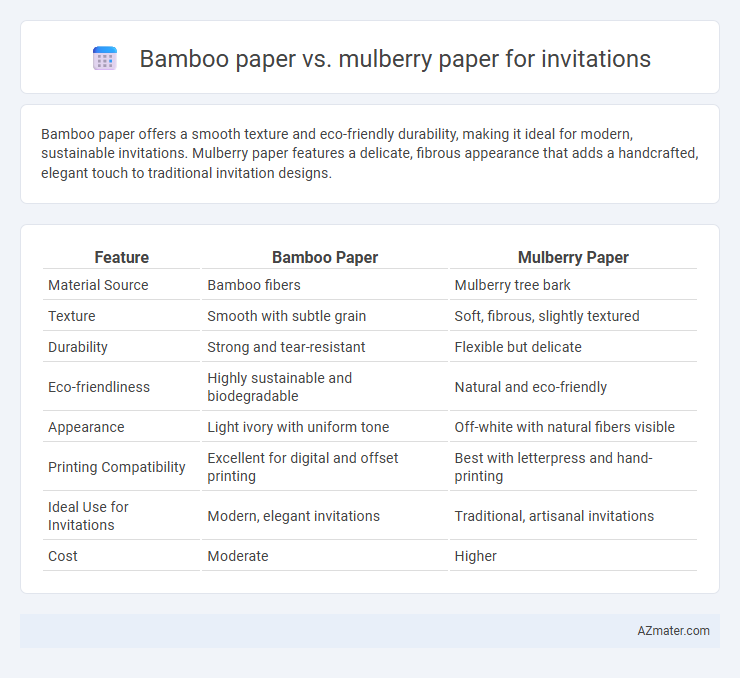Bamboo paper offers a smooth texture and eco-friendly durability, making it ideal for modern, sustainable invitations. Mulberry paper features a delicate, fibrous appearance that adds a handcrafted, elegant touch to traditional invitation designs.
Table of Comparison
| Feature | Bamboo Paper | Mulberry Paper |
|---|---|---|
| Material Source | Bamboo fibers | Mulberry tree bark |
| Texture | Smooth with subtle grain | Soft, fibrous, slightly textured |
| Durability | Strong and tear-resistant | Flexible but delicate |
| Eco-friendliness | Highly sustainable and biodegradable | Natural and eco-friendly |
| Appearance | Light ivory with uniform tone | Off-white with natural fibers visible |
| Printing Compatibility | Excellent for digital and offset printing | Best with letterpress and hand-printing |
| Ideal Use for Invitations | Modern, elegant invitations | Traditional, artisanal invitations |
| Cost | Moderate | Higher |
Introduction to Bamboo and Mulberry Paper
Bamboo paper, crafted from the fast-growing bamboo plant, offers exceptional strength and a smooth texture ideal for high-quality invitations. Mulberry paper, made from the inner bark of the mulberry tree, is renowned for its durability and distinctive fibrous appearance that adds a natural, handcrafted feel. Both papers are eco-friendly, with bamboo paper emphasizing sustainability through rapid renewability and mulberry paper prized for its traditional artisan roots.
Origin and Production Processes
Bamboo paper, derived from the fast-growing bamboo plant primarily found in Asia, is produced by processing bamboo fibers through mechanical or chemical pulping methods, resulting in a durable and eco-friendly sheet. Mulberry paper originates from the bark fibers of the mulberry tree, particularly Broussonetia papyrifera, and undergoes a labor-intensive process involving soaking, beating, and hand-laying fibers, which creates a strong, textured paper favored for traditional arts and invitations. Both papers emphasize natural fiber use but differ significantly in fiber source and production techniques, impacting their texture and appearance in invitation design.
Texture and Appearance Comparison
Bamboo paper offers a smooth, fine texture with a natural sheen, delivering an elegant and modern look ideal for sophisticated invitations. Mulberry paper features a fibrous, slightly rough texture with visible strands, creating a rustic and handmade appearance perfect for vintage or eco-friendly designs. Both papers provide unique tactile experiences, with bamboo paper emphasizing sleekness and mulberry paper highlighting organic, textured aesthetics.
Environmental Impact and Sustainability
Bamboo paper for invitations offers a highly sustainable option due to bamboo's rapid growth rate and ability to regenerate without replanting, significantly reducing deforestation. Mulberry paper, made from the bark of the Morus alba tree, supports eco-friendly harvesting since the bark regrows naturally, causing minimal harm to the tree and promoting long-term sustainability. Both materials provide biodegradable alternatives to traditional paper, but bamboo's lower water usage and faster cultivation cycle make it a more environmentally impactful choice.
Durability and Longevity
Bamboo paper offers exceptional durability due to its strong natural fibers, making it resistant to tearing and suitable for long-lasting invitations. Mulberry paper, crafted from the inner bark of mulberry trees, is renowned for its fibrous texture and flexibility but can be more delicate and prone to wear over time compared to bamboo paper. Invitations made with bamboo paper generally provide superior longevity, maintaining their structural integrity and appearance even after extended use or handling.
Printability and Ink Absorption
Bamboo paper offers excellent printability with smooth texture, enabling sharp, vibrant images and text ideal for detailed invitations. Mulberry paper, known for its fibrous and textured surface, absorbs ink deeply, providing a more organic, handcrafted look but may result in slightly diffused edges. Both papers support various printing methods, yet bamboo paper excels in digital and laser printing while mulberry paper favors traditional ink-based techniques for rich color absorption.
Customization and Design Versatility
Bamboo paper offers exceptional customization options due to its smooth texture and natural fiber strength, making it ideal for intricate printing and embossing techniques on invitations. Mulberry paper excels in design versatility with its unique handmade fibers, creating a distinct aesthetic that enhances watercolor effects and calligraphy. Both papers provide eco-friendly choices but differ in finish, where bamboo paper supports high-resolution detail, while mulberry paper offers a textured, artisanal look perfect for bespoke invitations.
Cost and Availability
Bamboo paper is generally more cost-effective and widely available due to the fast-growing nature of bamboo and its established commercial production. Mulberry paper, derived from the bark of mulberry trees, tends to be more expensive because of its labor-intensive harvesting process and limited regional availability, primarily in East Asia. For invitations, bamboo paper offers an affordable, eco-friendly option with consistent supply, while mulberry paper provides a unique texture and traditional aesthetic at a higher price point and less accessibility.
Ideal Use Cases for Invitations
Bamboo paper offers durability and a smooth texture ideal for elegant wedding invitations and corporate event cards that require a natural yet refined appearance. Mulberry paper, with its fibrous, handcrafted feel, suits rustic-themed or vintage-style invitations, providing a unique tactile experience and artistic appeal. Both papers are eco-friendly, but bamboo paper's firmness makes it better for intricate printing, while mulberry paper excels in handmade, calligraphy-driven designs.
Choosing the Right Paper for Your Event
Bamboo paper offers a smooth texture and eco-friendly appeal, ideal for modern, sustainable-themed invitations, while mulberry paper provides a unique, fibrous appearance perfect for rustic or artistic events. Consider the event's tone and aesthetic; bamboo paper suits minimalist and contemporary designs, whereas mulberry paper enhances handmade or vintage styles. Durability and printing compatibility also influence choice, with bamboo paper supporting crisp digital prints and mulberry paper best suited for calligraphy or textured finishes.

Infographic: Bamboo paper vs Mulberry paper for Invitation
 azmater.com
azmater.com